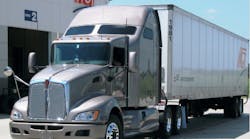Tom Kretsinger Jr., president and CEO of American Central Transport, does not mince words when it comes to the subject of installing driver-facing cameras in commercial trucks: Cameras are the only way to truly ensure a fleet’s drivers are following the proper safety protocols.
“Here is what I’ve found to be true: We set a safety policy with no real way to enforce it because at the end of the day a driver will do what they want to do,” he explained during a presentation at the 2016 Truckload Carriers Association (TCA) meeting earlier this month.
“That is why inward-facing cameras are so critical,” Kretsinger stressed. “Yes they don’t like them. But continuous improvement is what this is all about. [Cameras] tell us who to coach: the ones who text, who use the cell phone, who drive unbelted. The ones who exhibit the behaviors that increase their crash risk.”
Gary Johnson, director of risk and compliance for Lytx, added during the presentation that truck drivers on average make 163 decisions per mile, with many of them split-second in nature, which is why distractions pose a serious safety risk.
“Drivers have to deal with a ton of things out on the road and successfully dealing with them comes down to behaviors,” he said. “They have a very hard job and a lot rides on their performance. But the carrier’s job is hard as well. Winning repeat [freight] business so heavily depends on safe operation.”
Johnson noted that 95% of vehicle collisions result from driver-related human behaviors, with several indicators drawn from a recent “naturalistic” study of how behaviors correlate to crash risk:
- A driver who experiences a near-collision is six times more likely to be involved in an actual collision within six months;
- A driver that receives a traffic violation is 4.3 times more likely to experience a collision within six months;
- And a driver that regularly follows other vehicles too closely, with less two seconds worth of following distance, is 4.8 times more likely to experience a collision within six months.
American Central’s Kretsinger (seen at right) stressed that there is also an onus upon the carrier to spell out its safety policies in detail and enforce them fairly.
“Out of our core values, safety is on top; it’s non-negotiable, by the book, no exceptions,” he emphasized. “We might not like them all, but we follow them to the letter – that allows us to sleep at night.”
Yet Kretsiner pointed out that such a safety “vision” must be proactive to work effectively; one centered on coaching when it comes to the use of driver-facing cameras.
“We use event data recorders and cameras to prevent accidents, not pay claims afterwards,” he explained. “If we know what our drivers are doing, that often can lead to changes in what we are doing.”
For example, if a driver who’s been great for three years and suddenly gets a 15 mph over the limit ticket, are they a bad driver now?
“Do we fire them? Or if we know what they are doing can we correct the behavior that led to that ticket? Knowing what a driver is doing versus speculating on what they are doing allows us to be more proactive,” Kretsinger said. “We have the technology today that can let us control our future. I am a big believer in this.”




